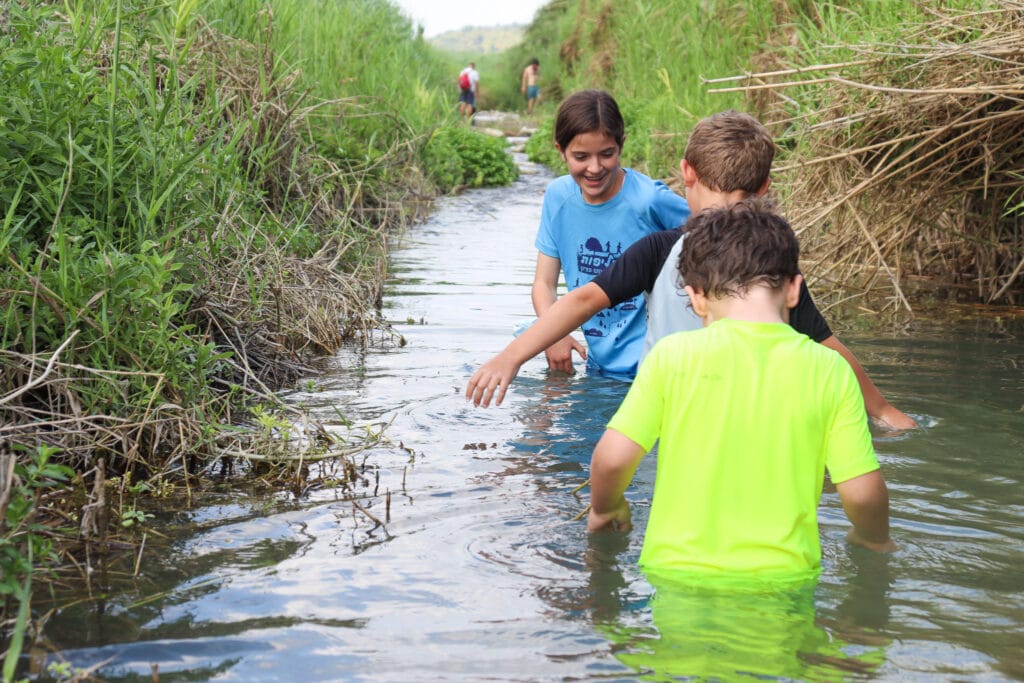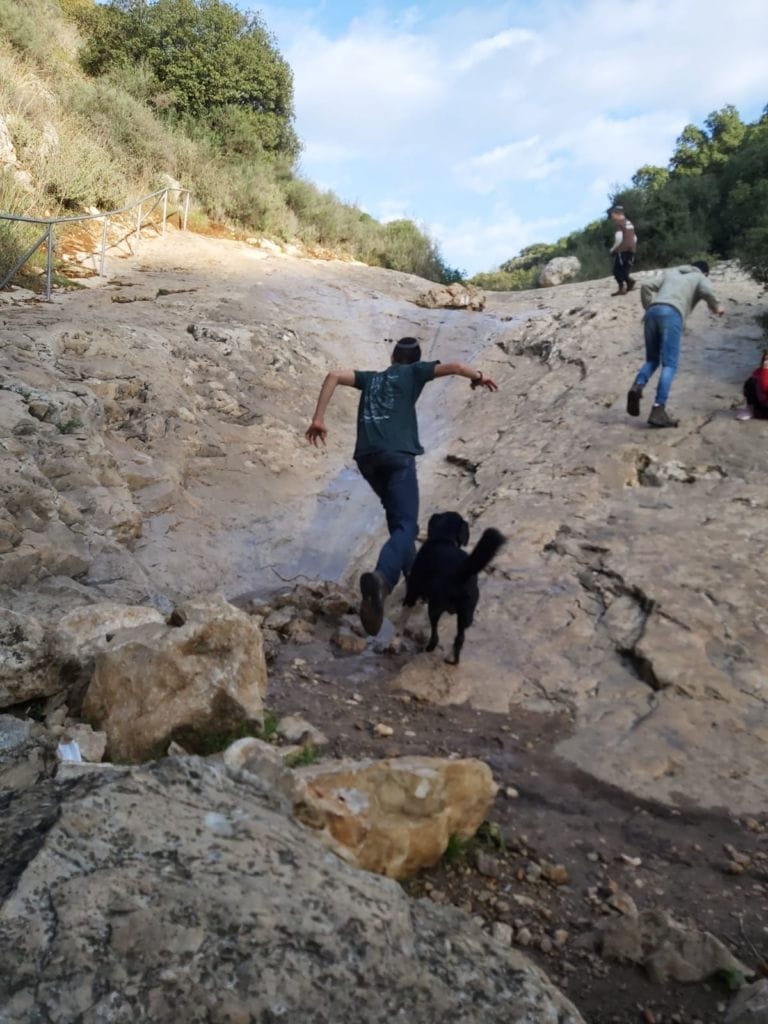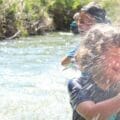
by Avigail Gimpel, M.S.
This week’s guest post was written by my dear friend Avigail Gimpel, an expert in the field of managing the challenges that come along with raising high energy kids. Here’s what she has to say:
Summer is upon us, HELP!
The camp day is very short, and most kids have no camp options in August. We parents are left with many unstructured hours to fill. For a parent of a highly energetic, curious child (read: kid diagnosed with ADHD) the prospect of all those unstructured hours is terrifying. We can already predict that our children will get bored, under stimulated, demand screen time, eat junk food all afternoon, pick on siblings and generally wreak havoc all summer.
How is a parent to help her/his child remain calm, happy and positively stimulated throughout the long, hot summer holiday?
The answer is literally all around us, but not inside our homes. Let’s step out the front door and discover the magical effects exercise and nature have on our children (and their parents) and see how this powerful combination will literally save your summer!
What does science have to say about the combination of exercise and nature and its effect of people with ADHD symptoms?
Dr. John Ratey, Associate Professor at Harvard medical school, tells us that rigorous exercise helps us control stress and calms our minds. Exercise boosts dopamine, that same neurotransmitter that we hear a lot about in connection to ADHD. Dopamine improves mood and a feeling of wellbeing and gets our attention system going. Serotonin is also stimulated by exercise. We need adequate serotonin for mood, impulse control, and self-esteem.

We are just getting warmed up. A study out of University of Granada, Spain found that children who were in good physical shape had more grey matter in specific areas of their brain. These regions are responsible for executive functioning, (planning, inhibiting, organizing, completing tasks…) the exact skills people with ADHD symptoms are missing. When researchers compared kids who did sports regularly and their couch potato peers, they found significant differences between the children. “The answer is short and forceful: yes, physical fitness in children is linked in a direct way to important brain structure differences, and such differences are reflected in the children’s academic performance,” said lead researcher Francisco B. Ortega (Esteban-Cornejo et al., 2017).
If we take a long hard look at the lives our children lead today, both during the school year and in summer, it doesn’t look like anyone is paying attention to the research. Our kids sit all day in school. When they are on vacation, they sit with their screens some more. Studies have shown that regular exercise preserves our brain and keeps it sharp as we get older. This brain growth is happening to our kids as they get out on the basketball court, baseball field or on a long challenging hike. Growth happens when they dance and practice martial arts. The brain slows when they play video games and tweet.
The first conclusion we can draw is that getting our children and ourselves moving is ideal for their mental, emotional and physical wellbeing. Is hiking more powerful than running on a treadmill?
Do you remember wandering through the woods after the rain to catch salamanders when you were a child? How about garden snakes, the kind that are not poisonous, did you stick them in your pocket? I sure did. And boy was it fun! When we came home after a day of exploration, we felt alive and stimulated.

Our physical health and emotional wellbeing depends on the loving embrace of mother nature. We can’t live without her. Can anyone live without Mama?
Richard Louv, in his national bestselling book Last Child in the Woods (Workman eBooks, 2008) tells us that “[a]s youth spend less and less of their lives in natural surroundings, their senses narrow, physiologically and psychologically, and this reduces the richness of human experience” (2008, p.3).
How important is nature exposure for our ADHD diagnosed children?
“As nature deficit grows, another emerging body of scientific evidence indicates that direct exposure to nature is essential for physical and emotional health. For example, new studies suggest that exposure to nature may reduce the symptoms of Attention Deficit Hyperactivity Disorder (ADHD), and it can improve all children’s cognitive abilities and resistance to negative stresses and depression.” (Louv, 2008, p. 35)
We recently took our kids out on a glorious springtime hike where I saw the impact that nature and physical exercise has on our children’s cognitive development, creativity and social skills. We found a remarkable trail, bursting with flowers and greenery. A stream ran through it. It took exactly one minute for all the kids to jump right into the rocky stream. How would everyone get across without falling? They worked together, hopping from stone to stone, carrying the youngest across (and their mother who didn’t want to get her new sneakers wet). They discovered a branch of a big, beautiful tree reaching across the stream right at an area where the water was deep enough to jump. Tarzan was the next game. And then we hit the “major find”! A mulberry tree overflowing with berries. Watching the kids strategize reaching the highest branches with the sweetest berries was fascinating. One found a stick laying on the ground that had a hook shape at the end. Another climbed the tree. A few kids took off their shirts and the kid in the tree shook the upper leaves with his hook, allowing the berries to fall into their nets (shirts). Their focus and teamwork were such a pleasure to observe and participate in. As they worked hard to gather berries one of my sons turned to me with a flushed cheek smile and said, “This is really fun!”


We need the forest and the field for our mental, physical emotional and spiritual wellbeing. We come from nature, we are part of nature, and we pay a steep price when we are separated from it.
What does nature do for us that makes it so invaluable, and impossible to live without?
“Nature inspires creativity in children by demanding visualization and the full use of the senses. Given a chance, a child will bring the confusion of the world to the woods, wash it in the creek, turn it over to see what lives on the unseen side of that confusion. Nature can frighten a child too, and this fright serves a purpose. In nature, a child finds freedom, fantasy, and privacy: a place distant from the adult world, a separate peace” (Louv, 2008, p.7). Nature is also calming and relaxing. There is no rush, just sounds and smells and soothing colors. We learn to use all our senses. When we are in class or at a computer, we spend our energy shutting out distractions, shutting down our senses. Nature awakens all our senses. We also become more creative and friendly. When we experience our own adventures, we create stories, instead of living through the eyes of a movie character. When we compare kids playing outdoors in nature to kids playing in closed areas or concrete lots, the children playing in nature are far more likely to invent their own games and be creative. Kids are also more sociable with each other when they play in nature and are using their imaginations.
Our second conclusion is that exercise in nature is much more powerful than a run on the treadmill.

From theory to practice. Here is how we can get our children out into nature to exercise this summer, and continue immersing ourselves in nature throughout the year:
- Make it social! We often hike with friends and family. Children will be happier to get out if they know their favorite friend or cousin will be there too.
- Choose a hike that is challenging for your gang, but not too difficult to discourage them. The challenge is great for them. It pushes them out of their comfort zone and builds confidence.
- Encourage kids to make “major finds” as they hike. Let them wander, play hide and seek. When we step back, they come up with their own imaginative games.
- Be a personal example by leading the hike, talking about how much you enjoy getting outdoors, how you feel when you are in the forest.
- A hike will never be able to compete with screens. If children know that they can either play a video game or lace up their hiking shoes, they will always opt for the former. Remove the screen as an afternoon activity option. Be a leader! Pack the picnic, head to the car and your kids will follow as long as there is no option of being on a screen of any sort. The more often you go out in nature, the more enthusiastic your children will be to participate. You may hear some grumbling on the first few outings, but soon enough the kids will be planning the outings with you.
- Leave the phones at home or in the car.
- Plan your outings in advance by finding great hikes through sites like Hiking the Holyland. Get your kids involved in choosing the hikes. Put a weekly schedule on the refrigerator so the kids can see what hikes you will be going on. Not all hikes have to be a full day adventure, there are plenty of short afternoon hikes, often right in your back yard.
- Be prepared with good walking shoes, a picnic, a hat and plenty of water.
Let this summer be the beginning of a discovery journey. Get out of the house and enter the beautiful world of the great outdoors. When you and your family combine nature and exercise you will immediately notice the positive transformation in your children.

Avigail Gimpel is a college lecturer, practitioner in private practice, parent educator, and author of recently published book HyperHealing – The Empowered Parent’s Complete Guide to Raising a Healthy Child with ADHD Symptoms.
Her passion is helping your healthy child diagnosed with ADHD, conduct disorder or learning disabilities flourish and achieve his/her best. She will guide you in helping your child find the right path to prove just how capable s/he is!
Once we rewrite his/her “manual” there will be no stopping your beautiful child.
Visit Avigail at https://www.hyperhealing.org/ or follow her on Instagram for tips on how to raise healthy children with ADHD symptoms.




